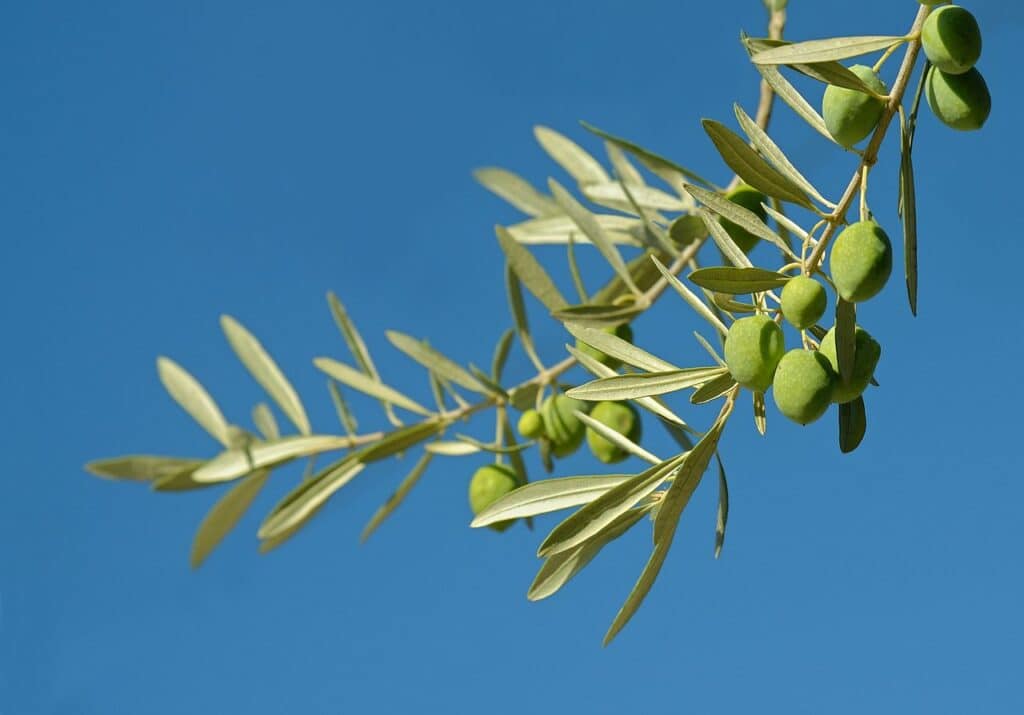Olive:
What are they?, history, cultivation, nutritional value, uses, recipes, and more...
The olive is the fruit of the olive tree, a plant native to Greece and Asia Minor. This fruit is consumed worldwide, both fresh and as oil (olive oil). Its main value lies in its high content of monounsaturated fats (70%), which are considered necessary and beneficial for the body.
Índice
What are Olives?
Olives are the fruit of the olive tree, a tree belonging to the Oleaceae family that can reach a height of about 15 meters. It has a wide trunk, erect and light gray in color, filled with protrusions and fissures. Its leaves are opposite, lanceolate, with short petioles, whitish undersides, shiny green tops, and can measure up to about 8 cm in length. The flowers are tiny, hermaphroditic, and grouped in inflorescences composed of ten to forty flowers, depending on the variety. They have four whitish petals and an intense fragrance. The fruits are olives, which are edible ovoid drupes measuring between 1 and 4 cm in length and 0.6 to 2 cm in diameter, with a single stone inside.
Initially green, they turn black as they ripen due to the synthesis of anthocyanins. It is from this fruit that one of the most appreciated oils in world gastronomy, olive oil, is obtained.
History of Olives
The cultivation of olive trees began in the Middle East approximately six thousand years ago and spread widely with the Hebrews, Greeks, and Romans.
It is believed that olives were used from the beginning for both oil extraction and fresh consumption. References from the 1st century AD indicate that they were already used as fresh food.
The greatest expansion of olive cultivation occurred in Roman Hispania under the rule of the Scipios. The Latin poet Avienus described the Ebro River in his work “Ora Maritima” as the “oleum flumen,” the river of oil.
In the 15th century, olive cultivation spread to various parts of the Americas through Spanish colonizers and Franciscan fathers.

Common Name of Olives
| Español | Olivo, Aceitunero, Aceituno, Olivera |
| Francés | Olive |
| Alemán | Olive |
| Inglés | Olive |
| Portugués | azeitona |
| Italiano | Oliva |
| Noruego | oliven |
| Ruso | олива |
| Holandés | olijf |
Scientific Name of Olives
Olea europaea
Taxonomy of Olives
| Reino | Plantae |
| División | Magnoliophyta |
| Clase | Magnoliopsida |
| Orden | Lamiales |
| Familia | Oleaceae |
| Género | Olea |
| Especie | O. europaea L., 17531 |
Synonyms of Olives
Olea pallida Salisb., 1796 nom. illeg.
Etymology of Olives
Olive: It comes from the Arabic الزيتونة-zaytūnah (which passed into Hispano-Arabic as az-zaytūna), which in turn comes from the Aramaic zaytūnā.
Oliva: It comes from the Latin ǒLĕa, -ae, borrowed from the Greek έλαία, with the same meaning of “olive tree, olive.”
Cultivation, Distribution, and Habitat of Olives
- Habitat
- Distribution
- Cultivation
Habitat of Olives
Currently, olives are cultivated in the Mediterranean basin, northern Africa, parts of the Atlantic basin, southern states of Australia, South Africa in the Cape region, New Zealand, northwestern and Cuyo provinces of Argentina, the United States, China, and the Caucasus, with Spain being the world's leading producer.
Although olives are a hardy species, they require specific conditions that limit their distribution mainly to Mediterranean climate zones. Olives are sensitive to frost and can tolerate temperatures down to -10 °C, although their cold resistance is a varietal characteristic. On the other hand, high temperatures are also detrimental to olives, especially during the flowering period. Although olive trees grow in a wide range of areas, they seem to develop better in areas with an annual rainfall between 600-800 mm.
The olive tree can grow in almost any type of soil, including dry ones. It requires minimal care apart from occasional pruning to remove older branches and allow light and air to penetrate the tree, aiding in even fruit ripening.
Olive propagation can be sexual or seed-based (reproduction) and asexual, vegetative, or agamic (multiplication) using portions or vegetative fragments of the mother plant. The most commonly used method is vegetative propagation or multiplication, as it allows for the maintenance of clones, i.e., obtaining genetically uniform material.
In this type of reproduction, a piece of the plant is used, known as the mother plant. One or more plants genetically identical to the plant they originated from are obtained. The olive tree also readily produces adventitious roots, making its propagation straightforward.
Distribution of Olives
Olive cultivation Geographical Distribution of Olives

La Libertad, Lima, Ica, Arequipa, Moquegua, Tacna
Availability of Olives
- March, April, May, June, July, August
Varieties of Olives
There are about two hundred known olive varieties worldwide. Most olive varieties are of European origin, especially from Spain, Italy, and Portugal. The main ones include:
-
Spain
Aloreña Arbequina Blanqueta Cordobesa Cornicabra Cornezuelo de Jaén Cuquillo or Lechín de Granada, Empeltre Gordal Hojiblanca Lechín Manzanilla cacereña Manzanilla sevillana Obregón Pico Limón Picual or marteña Picudo Serrana de Espadán Verdeja or castellana Verdial. There are different varieties: Verdial de Huevar Verdial de Vélez-Málaga Verdial de Badajoz or morisca
-
France
La Picholine
Niza -
Greece
Koroneiki
-
Israel
Barnea
-
Italy
La Bella di Cerignola, La Giarraffa, La Nocellara, La Sant'Agostino, La Taggiasca, Ascolana
-
Argentina
Arauco Cruz del Eje
-
Chile
Azapa
-
Peru
Ascolana Liguria Sevillana Gordal Manzanilla Pendolino
-
Morocco and Tunisia
Chenlaly Moroccaine Picholine
-
United States and Australia
Barnea Leccino italiana Manzanilla
Nutritional Value of Olives
Olives are a highly nutritious food. They contain a high dose of vitamin A, which is a great source of antioxidants such as acteosides, hydroxytyrosol, tyrosol, and phenyl propionic acids that help repair and prevent cellular damage. They also provide a significant amount of sodium and, to a lesser extent, iron, magnesium, potassium, phosphorus, and iodine.
Their main fat component is oleic acid, a nutrient that helps prevent cardiovascular diseases by reducing LDL cholesterol (“bad cholesterol”) and increasing HDL cholesterol (“good cholesterol”).
Furthermore, olives are an important source of vitamin E, which, like oleic acid, prevents the oxidation of cholesterol-carrying lipoproteins in the blood and other substances linked to the development of certain types of cancer.
They also have a high fiber concentration, which helps improve digestion and produces a satiating effect.
Health Benefits of Olives
Olives contain antioxidants and high amounts of essential oils such as omega-3 and omega-6, which are very beneficial for the body.
Contraindications or Side Effects
Like any food, excessive consumption of olives can have negative consequences on the body. Due to their high sodium content, moderate consumption is recommended, especially for people with hypertension, fluid retention, liver-related diseases, or kidney problems. It should also be considered that olives are relatively caloric, so excessive consumption can lead to weight gain.
Topical application of olive oil is not recommended for people with oily skin and a tendency to acne.
Additionally, pregnant or lactating women are advised to consult a doctor before taking olive leaf extract.
| 10 Porciones por Kilogramo | |
| Tamaño de porción | 100g |
| Cantidad por porción Calorías |
298 |
| Cantidad por 100g | |
| Energía | 1,247 kJ |
| Grasa Total | 32.1 g |
| Sodio | ● |
| Carbohidratos totales | 7.3 g |
| Carbohidratos disponibles | ● |
| Fibra Dietaria | ● |
| Proteínas | 0.8 g |
| Calcio | 86 mg |
| Fósforo | 55 mg |
| Zinc | ● |
| Hierro | 2.40 mg |
| Potasio | ● |
| Agua | 57.5 g |
| Cenizas | 2.3 g |
| Vitamina A | 0 μg |
| Tiamina (B1) | 0.03 mg |
| Riboflavina (B2) | 0.22 mg |
| Niacina (B3) | 0.80 mg |
| Vitamina C | 0.00 mg |
| Acido Fólico (B9) | ● |
| β-Caroteno | ● |
| Fuente: Tablas peruanas de composición de alimentos – Centro Nacional de Alimentación y Nutrición – Ministerio de Salud – Perú | |
Derived Products and Forms of Olive Consumption
Uses of Olive
The main use of olives is culinary, although they are also known for their rich nutritional value and their prominent role in the agro-export industry and olive oil production.
- Culinary
- Medicinal
- Industrial
Culinary Use of Olive
Olives are a highly versatile food and can be consumed fresh, dried, pickled, stuffed, in paste form, as oil, and more. They are commonly used as a side dish, in salads, as snacks, in bread, as a garnish, in pâté, as a dressing, and even in derived products such as olive oil.
Olives can be classified based on their color: green, with shades, or black. According to some experts, it is recommended to consume seven olives per day to take advantage of their numerous nutritional benefits.
In Peru, olives are highly appreciated in local gastronomy. They are commonly used as a filling in various signature dishes such as stuffed potatoes, stuffed caigua, or empanadas, or as a side dish in famous national dishes like tamal, papa a la huancaína, ocopa, escabeche, and ají de gallina.
Medicinal Use of Olive
In the case of olives, their leaves and fruits are used for medicinal purposes. Some of their main benefits include:
- Good for heart health due to their fatty content
- Facilitate digestion
- High potassium content, aiding in muscle recovery
- Improve memory
- Provide energy to the body due to their high iron content, especially in black olives (4% in green olives, 45% in black olives)
- Oleic acid and Vitamin E composition helps prevent and delay the appearance of wrinkles
- Provide a feeling of satiety
- According to the Institute of Fat (CSIC), olives help burn fat due to their high content of adiponectin, which promotes the elimination of fats from the body up to five hours after ingestion.
- High in fiber
- Gluten-free
- Provide magnesium to the body
Industrial Use of Olive
One of the primary industrial uses of the olive tree is the production of olive oil, which is obtained through mechanical pressing. Different grades of oil are obtained based on the type of olive, flavor, and production process, and can be virgin or extra virgin.
In recent years, olive pits have also been used as fuel. This energy source is gaining increasing reputation as it is environmentally friendly, has high calorific value (4,500 calories per gram), and is cost-effective (saves 70% more compared to gasoline or diesel consumption).
Regarding the agro-export industry in Peru, olive production in 2019 ranged between 140,000 and 180,000 tons, with approximately 40,000 tons allocated for export, 30,000 tons for olive oil production, and another 30,000 tons for domestic consumption.
- peru.info
- es.wikipedia.org
- es.wikipedia.org
- peru.info
- as.com
- lavanguardia.com
- ecured.cu
- lamolina.edu.pe
- shop.strato.com
- sinavimo.gob.ar
- natureduca.com
- elmundoysusplantas.blogspot.com
- collinsdictionary.com
- gastronomiaycia.republica.com
- cookcina.com
- aceitesvallejo.com/
- quiminet.com
- mascontainer.com
- remediospopulares.com



